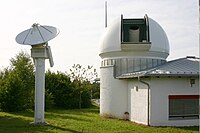
Photo from wikipedia
A hybrid satellite-terrestrial relay network (HSTRN) has been envisioned as a promising communication architecture for future wireless communications, which can prominently reduce the impact of shadow fading and expand service… Click to show full abstract
A hybrid satellite-terrestrial relay network (HSTRN) has been envisioned as a promising communication architecture for future wireless communications, which can prominently reduce the impact of shadow fading and expand service coverage. In this paper, we conduct theoretical performance analysis for a dual-hop communication system, consisting of multiple relays and multiple users in the HSTRN with the amplify-and-forward protocol. For the shadowing effect and the multipath effect, we introduce the shadowed-Rician distribution and Nakagami-$m$ fading to characterize the channel models for the satellite-relay and the relay-user links, respectively. Additionally, the opportunistic scheduling scheme is employed, where the optimal relay and the optimal user are selected from the alternative nodes with the maximum instantaneous signal-to-noise ratio. Thereafter, the analytical expressions including ergodic capacity and average symbol error rate (SER) are derived. More specifically, we also present the asymptotic behavior of the average SER at the high signal-to-noise ratio (SRN) regime. The theoretical analysis is validated by the numerical results. Moreover, the results also reveal that the performance of the system can be improved by increasing the number of relays and users under different channel parameters and various modulation schemes.
Journal Title: IEEE Transactions on Vehicular Technology
Year Published: 2022
Link to full text (if available)
Share on Social Media: Sign Up to like & get
recommendations!